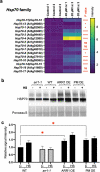Gain-of-function of the cytokinin response activator ARR1 increases heat shock tolerance in Arabidopsis thaliana
- PMID: 35535663
- PMCID: PMC9103500
- DOI: 10.1080/15592324.2022.2073108
Gain-of-function of the cytokinin response activator ARR1 increases heat shock tolerance in Arabidopsis thaliana
Abstract
In addition to its well-established role in plant development, the hormone cytokinin regulates plant responses to biotic and abiotic stresses. It was previously shown that cytokinin signaling acts negatively upon drought and osmotic stress tolerance and that gain-of-function of the cytokinin response regulator ARR1 causes osmotic stress hypersensitivity. Here we show that increased ARR1 action increases tolerance to heat shock and that this is correlated with increased accumulation of the heat shock proteins Hsp17.6 and Hsp70. These results show that the heat shock tolerance of plants can be elevated by increasing the expression of a cytokinin response activator.
Keywords: Arabidopsis; abiotic stress; cytokinin; heat shock; heat shock proteins.
Conflict of interest statement
No potential conflict of interest was reported by the author(s).
Figures



Similar articles
-
Functional characterization of type-B response regulators in the Arabidopsis cytokinin response.Plant Physiol. 2013 May;162(1):212-24. doi: 10.1104/pp.112.208736. Epub 2013 Mar 12. Plant Physiol. 2013. PMID: 23482873 Free PMC article.
-
ARR1 and ARR12 modulate arsenite toxicity responses in Arabidopsis roots by transcriptionally controlling the actions of NIP1;1 and NIP6;1.Plant J. 2024 Nov;120(4):1536-1551. doi: 10.1111/tpj.17065. Epub 2024 Oct 8. Plant J. 2024. PMID: 39378328
-
Cytokinin signaling stabilizes the response activator ARR1.Plant J. 2014 Apr;78(1):157-68. doi: 10.1111/tpj.12458. Epub 2014 Mar 5. Plant J. 2014. PMID: 24617630
-
Cytokinin action in response to abiotic and biotic stresses in plants.Plant Cell Environ. 2019 Mar;42(3):998-1018. doi: 10.1111/pce.13494. Plant Cell Environ. 2019. PMID: 30488464 Review.
-
The more, the merrier: cytokinin signaling beyond Arabidopsis.Plant Signal Behav. 2010 Nov;5(11):1384-90. doi: 10.4161/psb.5.11.13157. Epub 2010 Nov 1. Plant Signal Behav. 2010. PMID: 21045560 Free PMC article. Review.
Cited by
-
Cytokinin and abiotic stress tolerance -What has been accomplished and the way forward?Front Genet. 2022 Aug 9;13:943025. doi: 10.3389/fgene.2022.943025. eCollection 2022. Front Genet. 2022. Retraction in: Front Genet. 2024 Mar 19;15:1399259. doi: 10.3389/fgene.2024.1399259. PMID: 36017502 Free PMC article. Retracted. Review.
-
Plant Hormone Modularity and the Survival-Reproduction Trade-Off.Biology (Basel). 2023 Aug 17;12(8):1143. doi: 10.3390/biology12081143. Biology (Basel). 2023. PMID: 37627027 Free PMC article. Review.
-
Protein networks: integrating pathways for plant heat stress adaptation.Funct Integr Genomics. 2025 Sep 2;25(1):183. doi: 10.1007/s10142-025-01685-z. Funct Integr Genomics. 2025. PMID: 40890323 Review.
-
Phenomics and transcriptomics analyses reveal deposition of suberin and lignin in the short fiber cell walls produced from a wild cotton species and two mutants.PLoS One. 2023 Mar 9;18(3):e0282799. doi: 10.1371/journal.pone.0282799. eCollection 2023. PLoS One. 2023. PMID: 36893139 Free PMC article.
References
MeSH terms
Substances
LinkOut - more resources
Full Text Sources
Molecular Biology Databases
